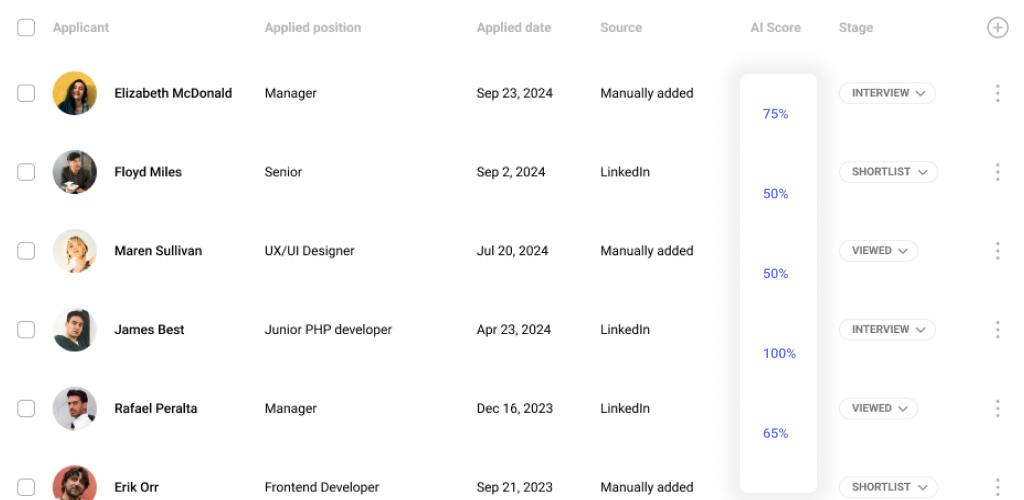Candidate screening is one of the most critical steps in recruitment, and also one of the most broken. Traditional processes rely on manual resume reviews, endless back-and-forth, and subjective judgments. The pain points are familiar:
- Volume overload: Job postings attract hundreds of applications, many irrelevant.
- Long hiring cycles: Weeks spent filtering candidates delay critical business needs.
- Unconscious bias: Screeners may favor certain names, schools, or formats.
- Inconsistent evaluation: Two recruiters may rate the same candidate very differently.
These inefficiencies cost organizations both time and talent. Promising candidates drop out due to long delays, while others are missed entirely because screening cannot keep up.
What is striking is that even when companies see the value, budget allocation is often the barrier. Many organizations still underinvest in candidate screening technology, treating it as a cost rather than a strategic enabler. This is unfortunate because modern AI in hiring tools is not just add-ons; they directly impact speed, quality of hire, and employer brand. Underfunding these areas means organizations risk falling behind in the race for talent.
The lesson is clear: traditional screening cannot keep pace with today’s recruitment challenges, and half-hearted adoption will not deliver results. To truly benefit, companies need to view AI candidate screening as a core part of their recruitment infrastructure, not a side experiment. SHRM’s 2025 benchmarking shows time-to-fill has converged to ~45 days for both executive and nonexecutive roles across organizations, a pace that simply does not scale in today’s talent market.
Table of Contents
ToggleWhat Is AI Candidate Screening?
Defining AI-Driven Candidate Screening
AI candidate screening refers to the use of artificial intelligence to analyze, evaluate, and filter job applicants. Unlike manual screening, automated candidate screening software uses algorithms to parse resumes, assess qualifications, and match candidates to roles based on structured criteria. This ensures consistency and removes much of the subjectivity that slows hiring down.
How ATS with AI Works
An ATS with AI (Applicant Tracking System with artificial intelligence) integrates AI features into traditional recruiting software. Beyond collecting resumes, it can:
- Parse documents for skills and experiences.
- Rank candidates against job requirements.
- Automate scheduling and communications.
- Provide recruiters with real-time analytics.
This allows recruiters to move from administrative gatekeeping to strategic talent planning.
Key Features: Resume Parsing, Matching, Automation
Modern resume screening software powered by AI delivers:
- Resume parsing: Extracts data like job titles, skills, and education automatically.
- Smart matching: Compares applicant profiles to job requirements contextually, not just through keywords.
- Recruitment automation: Streamlines early filtering, freeing recruiters for higher-value work.
Together, these features make AI recruitment faster, more reliable, and fairer.
Automated Resume Screening: Speed and Accuracy at Scale
AI Resume Screening vs. Manual Review
Manual resume screening is one of the most time-consuming parts of recruitment, and it is also where many mistakes happen. Recruiters often have to sift through hundreds of applications, skimming each for relevant experience while under pressure to move quickly. In such conditions, it is easy to overlook strong candidates or get bogged down by irrelevant details. Studies show that recruiters spend an average of six to seven seconds on an initial resume scan, hardly enough time to form a reliable impression.
This is where AI resume screening changes the game. By analyzing hundreds or even thousands of resumes in seconds, AI ensures nothing is missed. Unlike human reviewers, it does not get tired, distracted, or influenced by formatting issues. Recruiters who once felt overwhelmed by volume can now shift their energy toward interviewing and engaging candidates instead of drowning in paperwork.
Smarter Keyword and Contextual Matching
One of the biggest shortcomings of manual screening is its heavy reliance on keywords. A candidate might have the right skills but phrase them differently than the job description, causing their resume to be overlooked. For instance, a role that lists “data visualization” as a requirement might exclude someone who describes their experience in terms of “creating dashboards” or “using Tableau.”
AI solves this with contextual matching. Instead of exact keyword matches, it recognizes relationships between terms and skills. A finance professional who lists “forecast modeling” would still be surfaced for a role requiring “financial planning.” This not only reduces false negatives but also highlights hidden talent pools, people who may not use the exact corporate jargon but bring real-world expertise. Recruiters often describe the satisfaction of “finding gems” that the human eye might have missed, and contextual AI matching makes that discovery process scalable.
How Automation Accelerates Shortlisting
Perhaps the most transformative impact of AI resume screening is speed. By automating the first pass, recruitment automation drastically shortens hiring cycles. What once took weeks: manually filtering resumes, debating shortlists, and double-checking for missed candidates can now be achieved in hours. Faster screening translates into faster offers, which is critical when, as LinkedIn research shows, top candidates are off the market in just 10 days.
Consider the difference this makes for high-growth companies or industries facing talent shortages. Without automation, recruiters risk losing the best applicants to competitors simply because the process is too slow. With AI, recruiters not only move quickly but also feel more confident in their shortlists, knowing they are based on structured, consistent data rather than hurried judgments. For candidates, this speed improves their experience as well. No more waiting weeks for a response; instead, they feel valued and respected, which strengthens the employer brand.

AI-Powered Assessments: Beyond the Resume
Skills Tests and Video Interviews
Resumes can highlight experience, but they do not always reflect what a candidate can actually do. This is why AI assessments are gaining popularity. Skills-based tests such as coding challenges, data analysis tasks, or case studies reveal a candidate’s true capability in ways a CV cannot. For creative roles, AI-driven tools can evaluate design portfolios or writing samples with speed and accuracy.
Video interviews take this a step further. With the help of AI, recruiters can go beyond surface-level responses. The system can analyze how candidates explain complex problems, detect clarity in communication, or identify problem-solving approaches. For example, two candidates may give equally strong technical answers, but one communicates in a way that inspires confidence and collaboration. AI surfaces these distinctions, giving recruiters actionable insights they might otherwise miss.
Measuring Soft Skills and Cultural Fit
While technical expertise is essential, many failed hires are due to poor cultural fit or weak soft skills. The challenge is that qualities like teamwork, adaptability, and empathy are harder to measure. AI can help by evaluating how candidates respond in situational tests, how they use language in written responses, and even how they approach group problem-solving in gamified environments.
For example, an AI-driven assessment might present a candidate with a conflict resolution scenario and evaluate how they balance assertiveness with diplomacy. Or it might analyze patterns in a group exercise to see who naturally takes on leadership roles. These insights give recruiters structured, comparable data on traits that are otherwise subjective.
This does not mean removing human involvement; it means recruiters have richer data to guide conversations. Instead of asking, “Does this candidate seem adaptable?” they can point to evidence from AI assessments that support their decision-making.
Predictive Analytics in Candidate Evaluation
The real power of AI emerges when assessment results are combined with predictive analytics. By analyzing historical data on past hires, job performance, and retention, AI can estimate the likelihood of success for new candidates. This allows recruiters to identify not just who can do the job, but who will thrive and stay long-term.
For instance, Deloitte research shows that predictive models can reduce turnover by up to 20% by aligning hires with long-term business needs. Imagine two candidates with similar technical results: predictive analytics might reveal that one shares traits with high-performing employees who stayed and grew in the company, while the other resembles past hires who left within a year. These insights help recruiters make smarter, more strategic decisions.
The benefit is twofold: companies save costs by avoiding bad hires, and candidates are placed in roles where they are more likely to succeed. This creates a better experience for everyone involved, from the HR team to the new employee.
Reducing Bias and Improving Fairness with AI
Bias in hiring is well-documented. Candidates with certain names or backgrounds can face unfair disadvantages. AI offers tools to reduce unconscious bias and promote diversity.
Blind Screening and Structured Evaluations
Blind screening removes personal details like name or age, ensuring skills come first. Structured evaluations mean every candidate is measured on the same rubric, reducing subjectivity.
The Importance of Ethical AI Recruitment
AI is not bias-proof. To achieve bias-free hiring, companies must commit to ethical practices:
- Transparency: Recruiters must understand how AI evaluates candidates.
- Human oversight: AI supports, but does not replace, final decisions.
- Bias monitoring: Algorithms must be updated to prevent inherited bias.
- Compliance and trust: Ethical AI aligns with employment laws and builds candidate confidence.
Handled responsibly, AI in recruitment can drive both fairness and compliance.
Best Practices for Using AI in Early-Stage Filtering
Balancing AI Tools with Human Judgment
The most important best practice is remembering that AI should augment, not replace recruiters. Automated screening can process thousands of resumes quickly, but it cannot capture the full human story behind a candidate. Final decisions require empathy, context, and negotiation skills that only people can provide.
For example, an AI system may flag a candidate as underqualified based on a job description, but a recruiter might see transferable skills from another industry that the algorithm missed. In such cases, human judgment ensures promising candidates are not overlooked. The best outcomes come when AI handles the repetitive tasks and recruiters step in to interpret, challenge, and validate the results.
Keeping Screening Criteria Updated
Recruitment needs are never static. Skills in demand today may be irrelevant tomorrow. To stay competitive, companies must regularly update their screening criteria so that AI tools stay aligned with current and emerging requirements.
Consider fields like cybersecurity or data science, where new tools and certifications appear almost every quarter. If screening criteria are not refreshed, AI risks filtering out candidates with cutting-edge skills simply because they do not fit yesterday’s model. Regularly revisiting job requirements, competency frameworks, and success profiles ensures AI screening evolves alongside the business.
Ensuring Transparent and Fair Recruitment Automation
One of the biggest risks of AI recruitment is the “black box” problem, meaning no one knows exactly how the system makes decisions. To build trust with both candidates and stakeholders, transparency is key. Companies should communicate clearly about how automated screening works and what factors are being evaluated.
Recruitment automation should also be monitored closely. Regular audits of AI outputs help spot unintended bias or errors early. For instance, if data shows that certain groups are consistently underrepresented in shortlists, recruiters can intervene, adjust criteria, or retrain the system. This ensures compliance with labor laws while also promoting diversity and fairness.
When these practices are followed, organizations maximize efficiency without compromising ethics. AI can take care of scale and speed, while recruiters safeguard fairness and empathy. Together, they create a more balanced, effective, and human-centered hiring process.
Why Companies Choose Hirebee for AI-Powered Screening
There are many reasons to choose Hirebee; however, we have highlighted the advantages most often highlighted by our users.
Customizable Recruitment Workflows
Hirebee.ai recruitment software adapts to different industries and hiring needs. Recruiters can design workflows that balance automation with human oversight.
Automated Resume Parsing, AI Screening and Scoring
Hirebee’s platform integrates resume parsing software, AI candidate screening, and scoring models that prioritize skills and role alignment. This means better shortlists, faster.
Hirebee Success Stories and Results
Companies adopting Hirebee candidate screening consistently report measurable improvements in efficiency, quality, and candidate experience.
- Time-to-hire reduced by up to 32%: With automated resume parsing and AI scoring, hiring teams can generate shortlists in hours instead of weeks.
- Stronger quality-of-hire: Skills-based matching ensures candidates are evaluated on their real capabilities, not just keywords.
- Improved candidate experience: Faster responses and structured communication create a smoother journey for applicants.

These benefits are not theoretical, they are being realized by organizations today.
Ingo Insurance, a fast-growing company expanding its teams, faced the challenge of managing a rising number of applicants while maintaining high hiring standards. By implementing Hirebee, Ingo streamlined its recruitment workflow, cutting down administrative time and allowing HR managers to focus on candidate engagement. The result was a faster, more transparent process that gave both hiring managers and applicants confidence in the outcomes.
Similarly, Ayb School and the Ayb Educational Foundation needed a smarter way to recruit educators and support staff for their expanding educational programs. Using Hirebee’s AI-powered screening, Ayb was able to evaluate candidates more objectively, ensuring that teachers were assessed not only on credentials but also on skills and cultural fit. This shift improved the quality of hires and supported Ayb’s mission of empowering education through innovation.
These real-world examples illustrate how Hirebee turns screening from a bottleneck into a competitive advantage. By combining speed, accuracy, and fairness, Hirebee helps organizations in diverse industries, from insurance to education, build stronger teams while saving time and resources.
Future of AI in Candidate Screening
Predictive Hiring and Talent Forecasting
The next frontier is predictive hiring. By analyzing historical data, workforce trends, and skill gaps, AI can forecast future needs. This allows organizations to prepare talent pipelines in advance, lowering costs and reducing last-minute hiring. For example, a company anticipating digital transformation can begin sourcing cloud engineers months before demand peaks.
AI Chatbots for Candidate Pre-Screening
AI chatbots engage candidates at scale, answering FAQs, confirming interest, and handling basic pre-screening. This improves candidate experience while easing recruiter workloads. For high-volume hiring, chatbots ensure no candidate feels ignored. They also free up recruiters to focus on deeper interactions with the most promising applicants.
These AI recruitment trends highlight a future where efficiency, fairness, and personalization converge.
Conclusion
The era of manual resume stacks and gut-feel hiring is over. AI candidate screening delivers faster, fairer, and more efficient recruitment. From automated resume screening to AI-powered assessments and predictive analytics, companies can now make better decisions in less time.
Hirebee is at the forefront of this change. With customizable workflows, automated parsing, structured scoring, and proven customer results, Hirebee transforms candidate screening into a strategic advantage.
Ready to streamline your candidate screening process? Book a demo with our team and discover how AI transforms candidate screening!









